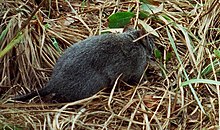Description
The woolly giant rat is an exceptionally large rat, it's very big and the largest living species of sigmodontine rodent, with short limbs and powerful claws. Nonetheless, individuals vary considerably in size, ranging from 19 to 29 cm (7.5 to 11.4 in) in head-body length, with a relatively short tail 15 to 20 cm (5.9 to 7.9 in) long. Body weight varies from 240 to 630 g (8.5 to 22.2 oz); no other sigmodontine species has a maximum weight above 400 g (14 oz). The fur is thick and coarse, with an almost uniform shade of dark grey or brown across the whole of the body, although slightly paler on the throat and underside. The tail is scaly and almost hairless, and dark grey to blackish in colour. The rhinarium is large, and the ears short and rounded. Females have eight teats. [2]
Distribution and habitat
Woolly giant rats inhabit the cerrado of central Brazil, and the Llanos de Moxos of northern Bolivia between 60 and 750 m (200 and 2,460 ft) elevation. Within Brazil, they are recorded from the states of Goiás, Mato Grosso and Rondônia. The rats live in areas of open grassland, grassy shrub, and savannah woodland, and are not found in more densely forested habitats. [2]
This page is based on this
Wikipedia article Text is available under the
CC BY-SA 4.0 license; additional terms may apply.
Images, videos and audio are available under their respective licenses.









